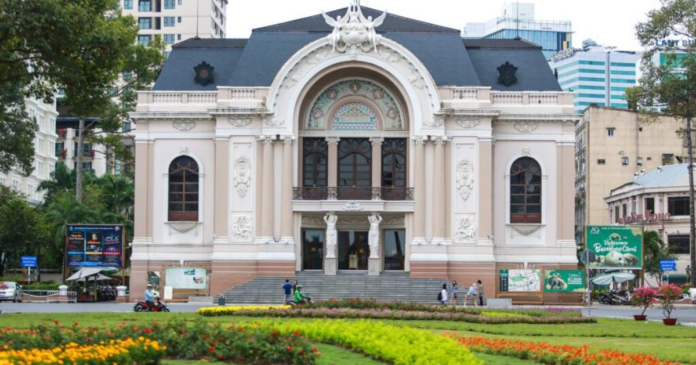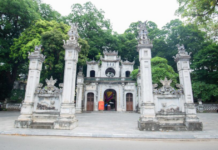Ho Chi Minh City Opera House, also known as Saigon Opera House, is a masterpiece of French architecture and a unique artistic destination. This is where ballet, opera, and Vietnamese cultural programs take place. Let’s explore this colorful symbolic beauty together!
1. General Introduction to Ho Chi Minh City Opera House
The Ho Chi Minh City Opera House, also known as Saigon Opera House, is a masterpiece of French architecture and a prominent cultural symbol. Built in 1898, the opera house harmoniously combines classical beauty with delicate details, offering a luxurious and romantic European atmosphere. From its soaring domed roof to the intricate carvings, every element exudes elegance and sophistication.
The opera house is a popular venue for a wide range of artistic programs. Moreover, it hosts famous performances such as the À Ố Show, Teh Dar, and The Mic, which take audiences on a cultural journey through Vietnam’s traditions. It is also an ideal space for major cultural and artistic events, attracting both domestic and international audiences. With its world-class architecture and longstanding artistic values, the Ho Chi Minh City Opera House has been recognized as a national heritage site since 2012, becoming a proud symbol in the preservation and promotion of Vietnam’s cultural values.
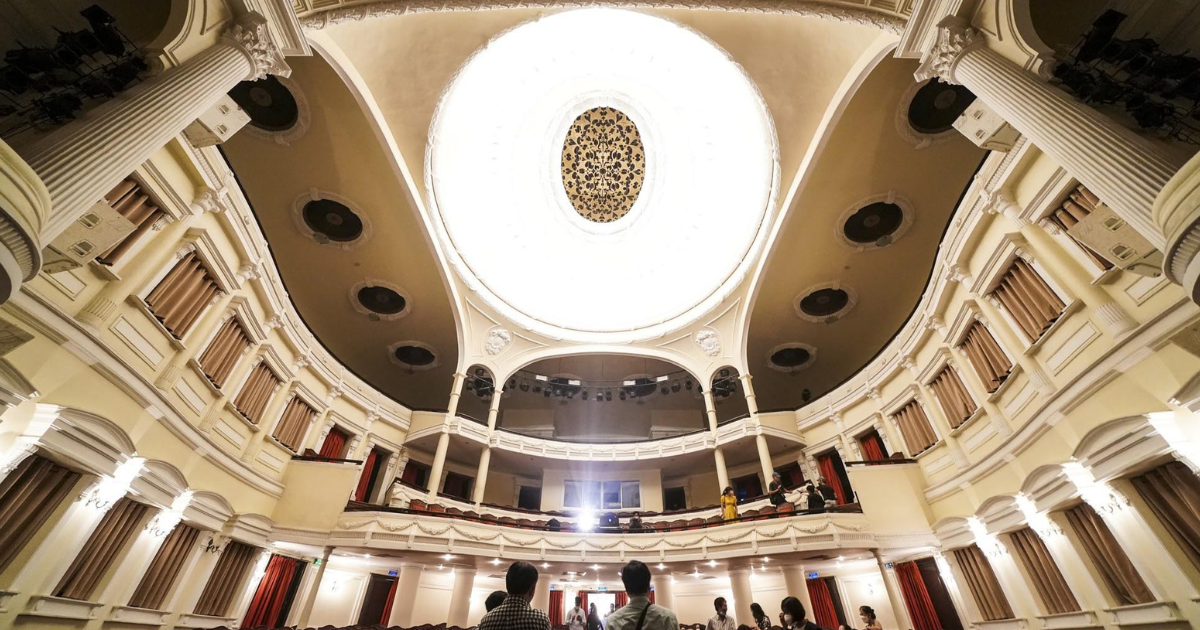
2. Location and Directions
2.1. Where is the Opera House?
The Ho Chi Minh City Opera House is located at 7 Cong Truong Lam Son, Ben Nghe Ward, District 1, Ho Chi Minh City. Positioned close to famous landmarks such as the Central Post Office, Nguyen Hue Walking Street, and Ben Thanh Market, the opera house’s location makes it easy for visitors to explore other nearby attractions. Its prime location also makes it an ideal stop for relaxation and enjoying the vibrant city scenery. Surrounded by hotels, restaurants, and cafes, visitors will have a variety of dining and shopping options. The beautiful location not only offers easy access but also provides a diverse experience, blending art, culture, entertainment, and cuisine.
2.2. How to Get There
To reach the Ho Chi Minh City Opera House, you have several transportation options. Located in the heart of District 1, on a major road, the opera house is easily accessible by private vehicle or bus.
If you choose to drive, finding your way there is simple. You can use Google Maps for detailed directions, and keep in mind that the area often hosts special events on weekends, so be sure to check for announcements and plan your trip accordingly.
If you prefer to take the bus, several convenient routes stop at the Opera House, including:
- Bus 03: Ben Thanh – Thanh Loc
- Bus 19: Ben Thanh – Vietnam National University
- Bus 45: District 8 Bus Station – Eastern Bus Station
You can also opt for other bus routes with stops nearby for a more convenient sightseeing schedule. With various transportation options, getting to the Ho Chi Minh City Opera House is easy and convenient for all visitors.
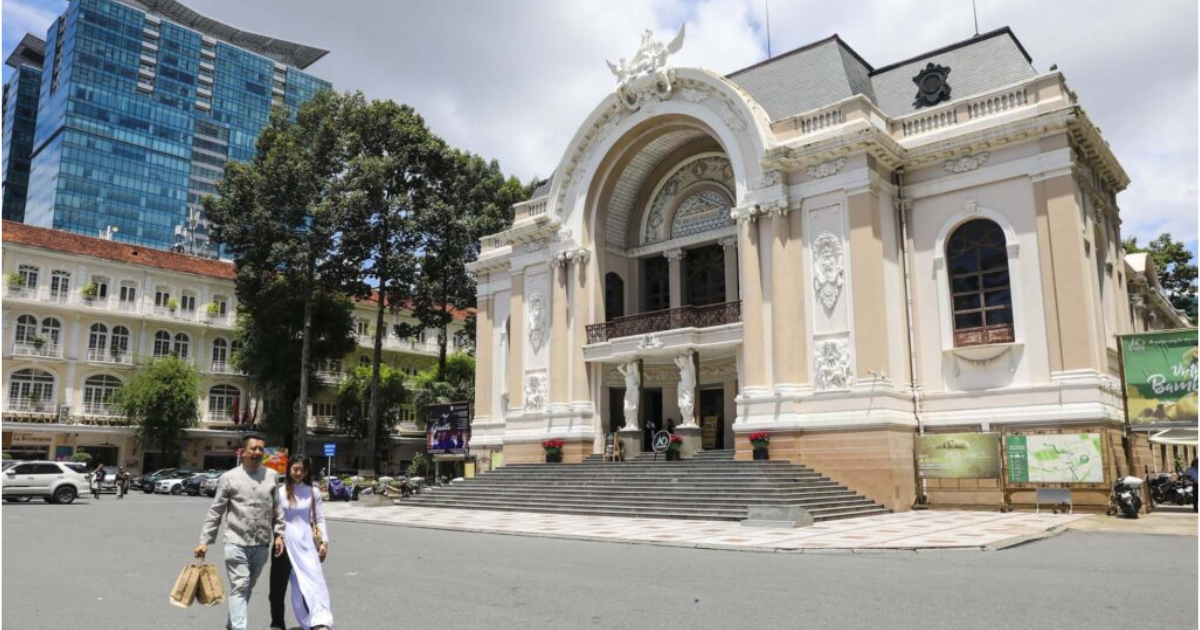
2.3. Parking Near the Opera House
When visiting the Ho Chi Minh City Opera House, you don’t need to worry about parking, as there are several nearby parking lots available. For added peace of mind, you can park at the opera house’s own parking lot, where prices are clearly listed. The lot is open from 8 AM to 10 PM, allowing you to enjoy the artistic programs without worrying about time. Parking here is not only safe but also offers easy access to other nearby attractions after enjoying the performances.
3. Distinctive Classical French Architecture
3.1. History of Formation
The Ho Chi Minh City Opera House, a symbol of French architecture in the heart of Saigon, was initiated in 1898 and completed in 1900. Under the guidance of three talented architects, Félix Olivier, Eugène Ferret, and Ernest Guichard, the project quickly became a landmark in the city’s cultural journey. Covering an area of 3,200 m² and with a seating capacity of up to 1,800, the opera house is not only a venue for grand artistic performances but also carries the distinctive mark of Gothic architecture, perfectly blending the intricate French details with ancient Greek-Roman styles.
Through the ups and downs of history, since 1955, the opera house has been transformed into the Southern Vietnam Assembly Hall and has undergone several renovations. Unique and captivating, the opera house attracts thousands of visitors both domestically and internationally, creating a vibrant artistic space with remarkable bas-reliefs and statues. Here, visitors can experience a special artistic environment, where valuable memories are preserved and it shines like a gem in the heart of the city.
3.2. Architectural Style
The architecture of the Ho Chi Minh City Opera House is a striking example of classical French style, with an unmistakable elegance, likened to a living art museum in the heart of Saigon. The façade of the opera house stands out with decorative details inspired by the Petit Palais Museum, reflecting the grace of late 19th-century French art. From a distance, the building appears majestic, like a grand gateway, while up close, its architectural beauty is elevated by large arches and high railings that rise harmoniously. Although many intricate carvings were removed in 1943, the stone statues, bronze sculptures, and white stone porch at the entrance still maintain the unique charm of the building.
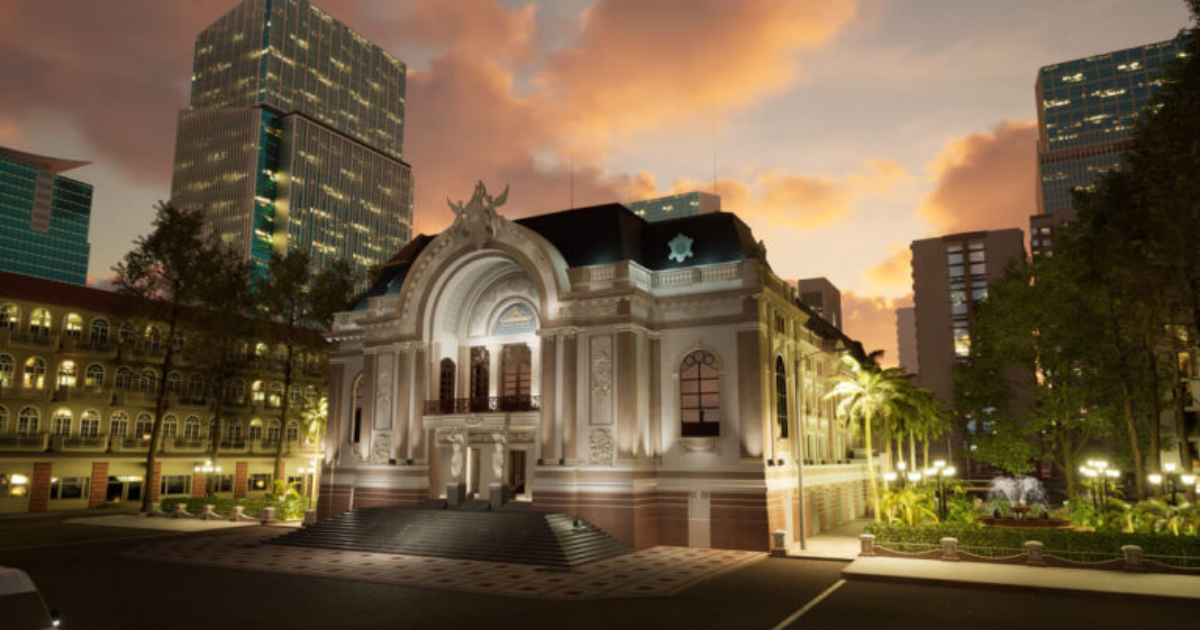
The interior of the opera house captivates visitors even more. The main lobby sparkles with granite tile floors, crystal chandeliers, and decorative materials imported from France, creating an elegant atmosphere. Particularly, the carved ceiling of the auditorium and the wall sculptures evoke the feeling of stepping into a royal French palace. As night falls, the lights illuminate the architecture, highlighting its luxurious and ancient beauty, making it the perfect backdrop for artistic check-in moments. Opposite the opera house is the spacious Lam Son Square, which enhances the romantic atmosphere, making the Ho Chi Minh City Opera House a precious gem in the heart of the vibrant urban landscape.
>> Vinpearl Nha Trang Travel: A Complete Travel Guide from A-Z for 2025
4. Notable Art Performances
4.1. À Ố Show
À Ố Show, held at the Ho Chi Minh City Opera House, is a unique artistic work that takes the audience back in time to the simple, peaceful image of the Southern Vietnamese countryside. The name “À Ố” is a playful wordplay, derived from the phrase “Làng Phố,” inviting viewers to explore the contrast between traditional beauty and the rapidly changing modern life. The show is a creative blend of bamboo circus, contemporary dance, acrobatics, and Vietnamese folk music, providing a multi-dimensional experience rich in Vietnamese culture.
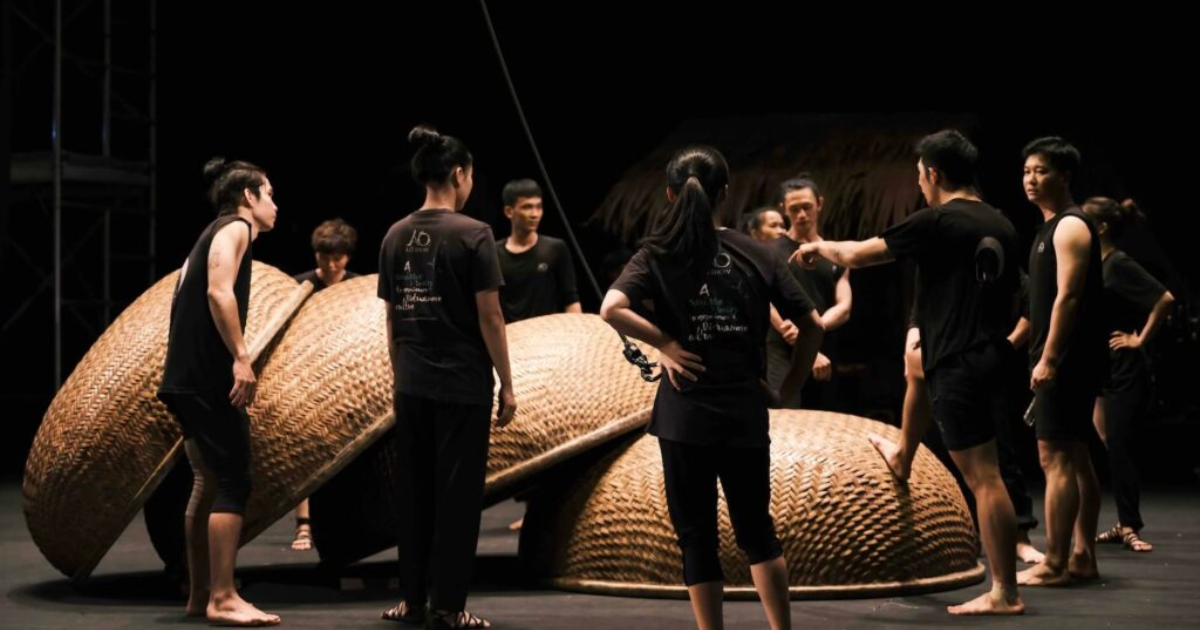
In an hour-long performance, À Ố Show vividly depicts the beauty and hardships of daily life in the Southern countryside. From scenes of daily activities to images of bamboo boats and rice fields, the show presents moments that are both rustic and expansive. The audience is drawn into the familiar atmosphere of the village through traditional props, authentic sounds, and seamless acrobatics and dance. This delicate and sincere portrayal is what makes À Ố Show a distinctive artistic highlight at the Ho Chi Minh City Opera House, attracting not only domestic visitors but also international friends.
4.2. The Mist
While À Ố Show offers an interesting perspective on the culture of the Southern countryside, The Mist takes the audience into the peaceful life of Vietnamese farmers and rice-cultivation culture. Through each scene, the show depicts the rhythm of rural life, from misty mornings to the vibrant sunsets after a day of hard labor.
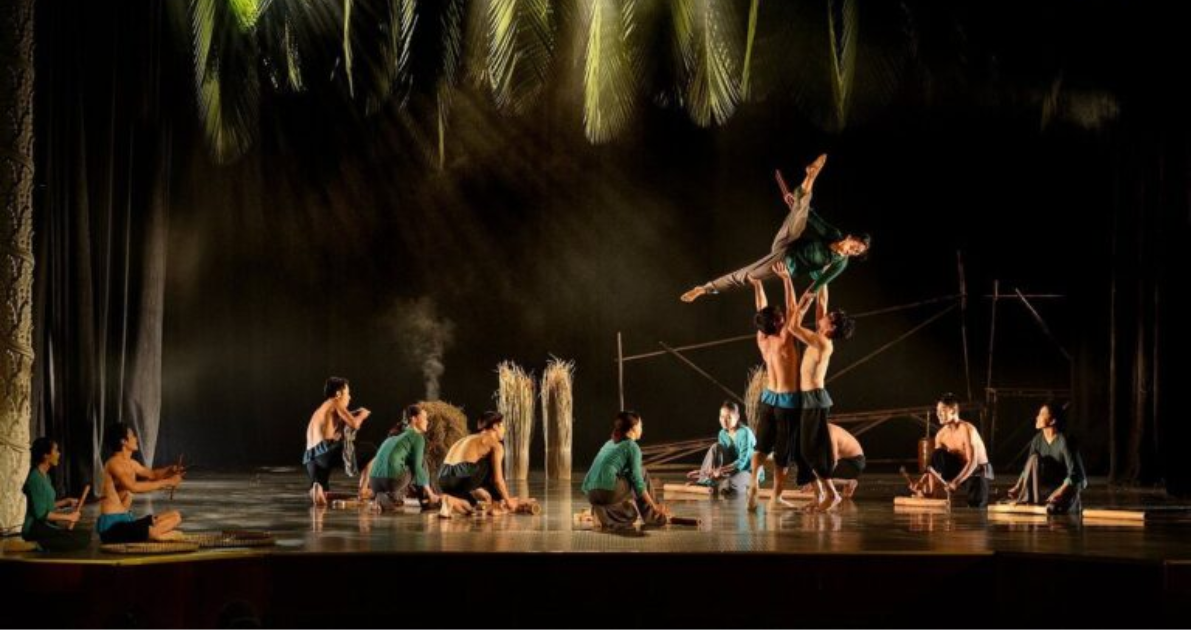
The Mist stands out with its combination of neoclassical and modern dance, with performers skillfully portraying the entire rice farming process—from sowing seeds, transplanting rice, and caring for crops, to the harvest. The soft lighting and countryside music immerse the audience in the vast rice fields. Not only an artistic performance, The Mist is a touching story about the perseverance and love farmers have for the land and rice—a longstanding cultural symbol of Vietnam. Audiences attending The Mist will feel nostalgic for the countryside through the dance movements and rhythmic beats, as if stepping into a poetic landscape painting, where each scene and movement holds deep meaning, reminding us of timeless traditional values.
>> Phung Khoang Market: The Ultimate Guide to Dining and Shopping “Unmissable” Experiences
4.3. Teh Dar Show
Following the countryside atmosphere of The Mist, Teh Dar Show will immerse you in the mystical and colorful world of Central Highlands culture. Inspired by the life and culture of the K’ho ethnic group, Teh Dar is a fusion of daring acrobatic art and unique traditional musical instruments. A standout feature of the show is “Bamboo Cirque” – a form of circus that uses bamboo as the main prop, recreating the image of the mountains and forests with spectacular moves, creating a magical and captivating atmosphere that transports the audience into ancient stories of the highland people.

With powerful, forest-inspired music, Teh Dar portrays the wild beauty and free-spirited nature of the Central Highlands. The audience will experience a range of emotions through the resonating gong, the sound of the bamboo flute, and the lively drumbeats, as if embarking on an emotional journey through the customs and rituals of the indigenous people. This is an unmissable performance for those who wish to touch the soul of Vietnamese culture and feel the strong connection with nature through each intense act.
4.4. Classic Opera and Ballet
At the Ho Chi Minh City Opera House, you will be immersed in a magnificent artistic space through classic operas and ballets. This is where musical masterpieces come to life, from famous classical melodies to elaborate choreographies, taking the audience through a wide range of emotions. Talented artists guide you through the story with graceful movements and soulful notes, offering an experience that is both captivating and elegant.
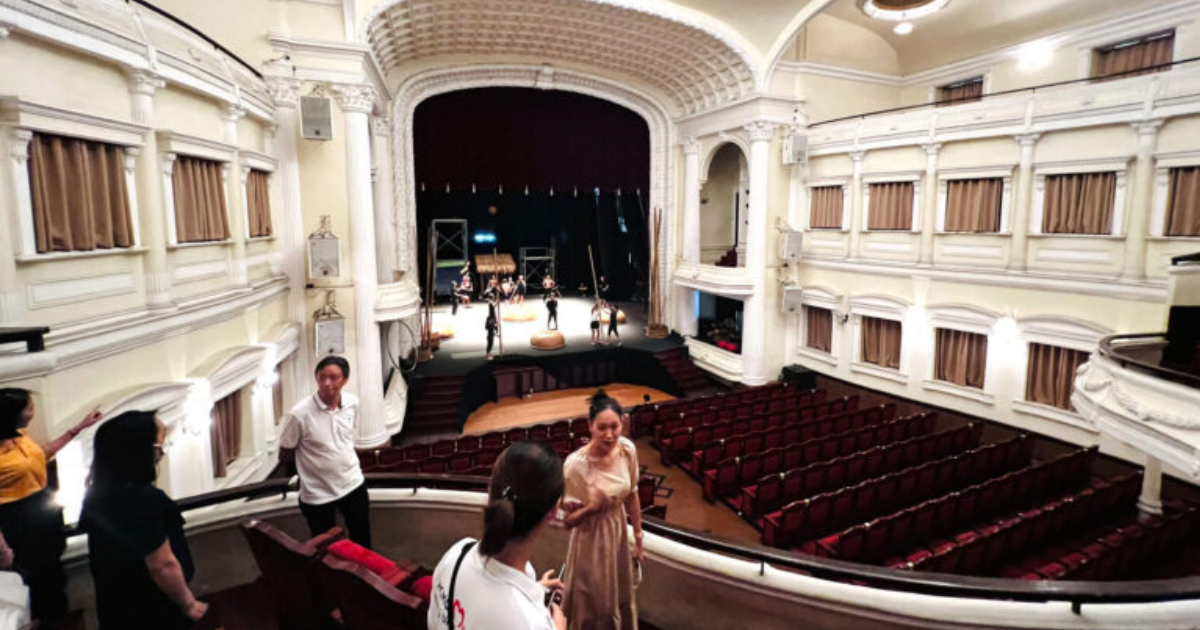
The classic opera and ballet performances at the Opera House are a perfect combination of melodious sounds, enchanting lighting, and a luxurious stage. The audience will have the opportunity to witness the world’s greatest works, conveyed with passion and attention to detail. This is definitely an unforgettable experience for those who love classical arts and wish to experience the essence of music and dance in the historic setting of the Ho Chi Minh City Opera House.
5. Things to keep in mind when visiting the Ho Chi Minh City Opera House
Check the schedule and book tickets in advance: The Opera House often hosts many exciting programs, so it is recommended to check the schedule and purchase tickets ahead of time to avoid missing out.
Arrive 15-30 minutes early: Arriving before the showtime allows you to settle into your seat and have time to explore and take photos before the performance begins.
Avoid bringing smelly food and drinks: To maintain the respectful atmosphere and not disrupt others’ experience.
Dress appropriately and neatly: Wearing formal and tidy clothing helps you blend into the artistic environment and shows respect for the space.
Bring a camera for souvenirs: You are welcome to take photos with the Opera House as a memento, but please refrain from taking pictures during the performance to avoid disturbing the show.
>> Khai Nguyen Pagoda in Hanoi: A Prominent Spiritual Destination with Unique Architecture
The Ho Chi Minh City Opera House is not only an iconic architectural masterpiece but also a unique cultural destination that preserves the essence of Vietnamese art and culture. From its classical French beauty to the outstanding performances, the Opera House offers an unforgettable experience, making every visit a wonderful journey of emotions and discovery!
Follow MyHuy Global to stay updated with exciting travel experiences!


